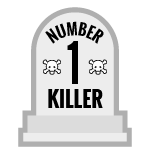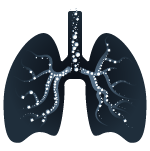Lung Cancer is The Top Cancer Killer in Louisiana, the U.S., and The World.
 It is estimated to have caused an estimate 154,050 deaths in 2018. 2,580 of those were in Louisiana. Almost all of these deaths are preventable.
It is estimated to have caused an estimate 154,050 deaths in 2018. 2,580 of those were in Louisiana. Almost all of these deaths are preventable.
Big Tobacco Targets At-Risk Demographics.
The evidence shows that tobacco companies (also known as “Big Tobacco”) target populations more at risk for smoking, including young people and minorities. These quotes are from tobacco company employees:
“We don’t smoke that s***. We just sell it. We reserve the right to smoke for the young, the poor, the black and stupid.”
–[Giovanni, J, “Come to Cancer Country; USA; Focus,” The Times of London, August 2, 1992].
“Today’s teenager is tomorrow’s potential regular customer, and the overwhelming majority of smokers first begin to smoke while still in their teens… The smoking patterns of teenagers are particularly important to Philip Morris.”
–[Johnston, E. Myron, “Young Smokers: Prevalence, Trends, Implications, and Related Demographic Trends,” March 31, 1981, Bates No. 1000390803].
“Cherry Skoal is for somebody who likes the taste of candy, if you know what I’m saying.”
-[Freedman, A, “Juiced up: How a tobacco giant doctors snuff brands to boost their ‘kick,’” Wall Street Journal, October 26, 1994].
Tobacco Costs Taxpayers Billions of Dollars.
 The Centers for Disease Control and Prevention says smoking-related illnesses in the United States cost more than $300 billion each year – nearly $170 billion in direct medical care costs and more than $156 in lost productivity, including $5.6 billion due to secondhand smoke exposure. These figures do not include the added costs that smoking drives up in private insurance premiums. In Louisiana, smoking-related illnesses costs $1.89 billion in direct medical costs – including $803 million in Medicaid, as well as $2.49 billion in lost productivity. That amounts to an approximate $1,220 in taxes per Louisiana household. Get more economic stats about tobacco from the CDC.
The Centers for Disease Control and Prevention says smoking-related illnesses in the United States cost more than $300 billion each year – nearly $170 billion in direct medical care costs and more than $156 in lost productivity, including $5.6 billion due to secondhand smoke exposure. These figures do not include the added costs that smoking drives up in private insurance premiums. In Louisiana, smoking-related illnesses costs $1.89 billion in direct medical costs – including $803 million in Medicaid, as well as $2.49 billion in lost productivity. That amounts to an approximate $1,220 in taxes per Louisiana household. Get more economic stats about tobacco from the CDC.
You Can Get Immediate Health Results When You Quit Smoking.
Quitting smoking at any time and at any age has benefits:
- 20 minutes after your last cigarette, your heart rate drops
- Within 2 weeks to 3 months after quitting, your heart attack risk begins to drop and your lung function begins to improve
- 1 year after quitting, your risk of coronary heart disease is half of that of a smoker’s
- 2 to 5 years after quitting, your stroke risk is reduced to that of a non-smoker’s and your risk for cancers of the mouth, throat, esophagus and bladder is halved at 5 years.
- 10 years after quitting, your lung cancer death rate is about half of that of a smoker’s and your risk of kidney and pancreas cancer decreases
- 15 years after quitting, your risk of coronary heart disease is back to that of a nonsmoker’s.
Check out more benefits from the CDC and ACS.
There Is Now A Lung Cancer Screening for High Risk People.
 A test known as a low-dose CAT scan or CT scan (LDCT) can help find abnormal areas in the lungs that may be cancer. Doing annual LDCT scans to screen people at higher risk of lung cancer can save lives. Click here to find out if you’re eligible and where to get screened.
A test known as a low-dose CAT scan or CT scan (LDCT) can help find abnormal areas in the lungs that may be cancer. Doing annual LDCT scans to screen people at higher risk of lung cancer can save lives. Click here to find out if you’re eligible and where to get screened.






